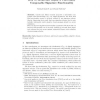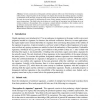456 search results - page 9 / 92 » Rethinking Digital Signatures |
ACNS
2004
Springer
13 years 11 months ago
2004
Springer
Motivated by the conflict between authenticity and privacy in the digital signature, the notion of limited verifier signature was introduced [1]. The signature can be verified by a...
ACSC
2004
IEEE
13 years 11 months ago
2004
IEEE
One of the primary flaws with current digital signature technology is that a digital signature does not "feel" or resemble a traditional seal or personal signature to th...
ISW
2004
Springer
14 years 28 days ago
2004
Springer
Abstract. Canetti and Rabin recently proposed a universally composable ideal functionality FSIG for digital signatures. We show that this functionality cannot be securely realized ...
PROVSEC
2010
Springer
13 years 5 months ago
2010
Springer
Generic constructions of designated confirmer signatures follow one of the following two strategies; either produce a digital signature on the message to be signed, then encrypt th...
IJNSEC
2010
13 years 2 months ago
2010
Digital Signature Algorithm (DSA) is an underlying algorithm to form a signature in the Digital Signature Standard (DSS). DSA uses a new random number (or nonce) each time a signa...


